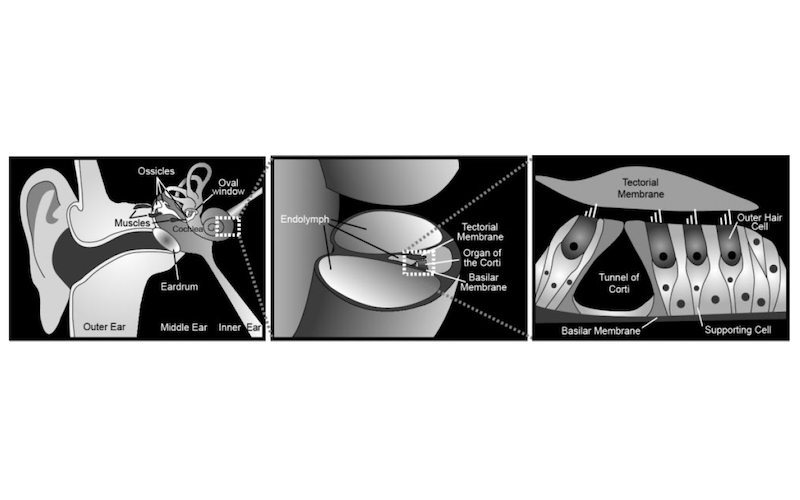
The most frequently cited example of mechanobiology is bone mineralisation. Compact bone is comprised of concentric layers of bone matrix, in which small cavities known as lacunae are interspersed at regular intervals. These lacunae harbour specialised cells called osteocytes. They are connected through canaliculi, a network of interconnecting canals. Gravity and compressive forces, which are generated by muscle contractions during movement, result in small deformations of the bone which drive pressure gradients and fluid flow through the lacunae–canalicular network. This fluid flow stimulates localised bone remodelling and material turnover.


Interestingly, hearing is an example of a mechanobiological pathway which converts sound waves, pressure and gravity into electrochemical signals. These mechanical forces cause small displacements in the stereo cilia of hair cells in the inner ear. The deflection of the stereocilia causes tension in the tip links, small extracellular filaments that connect the tips of stereocilia with adjacent stereocilia, thereby pulling open mechanically responsive ion channels. Once open, ion influx initiates further downstream signalling. Motor proteins, which are located at the distal ends of the tip links, can relax or contract to restore resting tension – thus providing a mechanism which allows the system to adjust to dynamic stimulation.


The following section describes the particular processes, material scales and architecture of mechanobiology which underpin biomechanical homeostasis.
Biomechanical homeostasis is achieved through the integration of two processes:
mechanoreception is the activation of free nerve endings by mechanical forces. These free nerve endings are located throughout the extracellular matrix of the entire body – information arising from these free nerve endings is processed by the insular and somatosensory cortices. Integration of neural information that arises from mechanoreceptors informs our ‘sense of the material and physiological condition of the body’ (B. Craig). This process is spontaneous, subconscious and integral to the regulation of biomechanical homeostasis.
mechanotransduction involves the translation of mechanical force into cellular and extracellular signals which inform structural reorganisation. Reorganisation entails a cascade of events which may include: changes in cellular morphology and behaviour, remodelling of the extracellular matrix, modified cell to cell communication, altered cellular biochemistry and ultimately adaptive regulation of gene expression. This process does not directly involve the nervous system but instead relies on chit chat amongst mechanosenstive molecules which translate mechanical forces into meaningful cellular communication and responses.
FEATURED IMAGE:
Donald E. Ingber. Cellular mechnotransduction: putting all the pieces together (2006).
